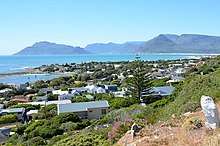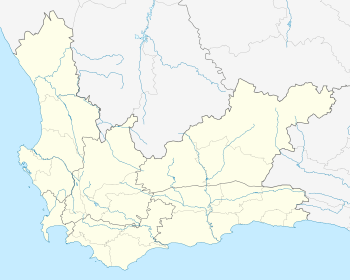Kommetjie
Kommetjie (Afrikaans for "small basin," approximately pronounced cawma-key) is a small town near Cape Town, in the Western Cape province of South Africa. It lies about halfway down the west coast of the Cape Peninsula, at the southern end of the long wide beach that runs northwards towards Chapman's Peak and Noordhoek.

Kommetjie | |
|---|---|
 Kommetjie viewed from Hout Bay | |
 Street map of Kommetjie | |
 Kommetjie Street map of Kommetjie  Kommetjie Kommetjie (South Africa) | |
| Coordinates: 34°08′25″S 18°19′45″E | |
| Country | South Africa |
| Province | Western Cape |
| Municipality | City of Cape Town |
| Main Place | Kommetjie |
| Area | |
| • Total | 2.56 km2 (0.99 sq mi) |
| Population (2011)[1] | |
| • Total | 2,435 |
| • Density | 950/km2 (2,500/sq mi) |
| Racial makeup (2011) | |
| • Black African | 2.7% |
| • Coloured | 3.5% |
| • Indian/Asian | 0.4% |
| • White | 92.0% |
| • Other | 1.3% |
| First languages (2011) | |
| • English | 86.5% |
| • Afrikaans | 10.3% |
| • Other | 3.2% |
| Time zone | UTC+2 (SAST) |
| Postal code (street) | 7976 |
| PO box | 7976 |
The area is a popular spot for surfing, since powerful waves from the Atlantic Ocean rise up over rocky reefs formed by hard sandstones of the Table Mountain Group. Wherever the bottom is rocky, the shallower waters are thick with giant kelp forests.
Kommetjie is famous for its excellent crayfishing despite recent changes in fishing quotas which have seen a drastic reduction in the daily catch allowed.
It is the hometown of the South African singer-songwriter Jeremy Loops.

Local Business

Kommetjie supports a small number of small enterprises, including a Shell garage (including a Shell Select), a convenience store, a laundromat, a small mail-order computer business, a video shop, a café, and a variety of restaurants.
Kommetjie, Afrikaans for “small basin”, is situated below mountains, which support part of the Cape Peninsula. The town boasts the Slangkop Lighthouse, situated on the beach, which stands about 33 meters tall. The lighthouse can be seen from the mountain pass "Ou Kaapse Weg" and has been around since 1919. The famous Pick 'n Pay Argus Cycle Tour passes each year through this small town which is also popular for local and international surfing. It is situated on the Atlantic Ocean with cold currents in this region and attractive waves for surfing, as well as crayfish and fishing. It is a quiet and relaxing town ideal for camping and getaways. Not far from Kommetjie, along Long Beach near Noordhoek, lies The Kakapo Shipwreck, which ran aground in 1900.
Fauna and Flora
Kommetjie hosts a variety of plant and animal species, many of which are endangered. Kommetjie is especially well known for its Milkwood groves, birdwatching and baboon troops, which frequently come down from their home on the nearby hills to raid for food among the residences.
Kommetjie is also part of the fynbos biome, which boasts the highest number of plant species per square kilometre. Some of the rarest and most sought after plants are found in this biome, but face threat from a variety of aliens, mostly Australian plants, imported in the 1800s. In a twist of irony, some fynbos plants have now become invasive aliens in parts of Australia.
References
- "Sub Place Kommetjie". Census 2011.
External links
| Wikimedia Commons has media related to Kommetjie. |

- Official Community Website
- Kommetjie Weather Station
.svg.png)